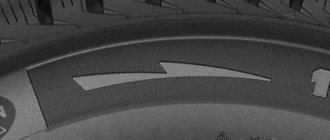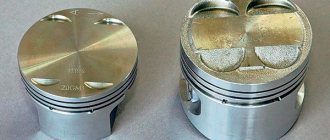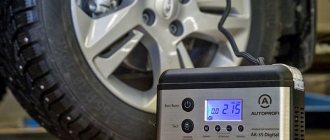Gray dusty wheels can ruin the impression of even a new car. And it’s not even that the tires look old and unkempt. Poor road surfaces and reagents wear them out. Rubber blackening is a procedure that will return the wheels to their original color and protect them from adverse influences.
DIY methods for blackening rubber
You can reduce the cost of tire retreading by making your own rubber ink.
Available and inexpensive products are suitable for this - glycerin, shoe polish, laundry soap or silicone oil. In the process of blackening wheels with your own hands, it is important to follow several rules:
- Wash and dry the tires before processing;
- Apply the compound only to the side parts of the wheels;
- even if there is a sprayer on the bottle, it is better to use a foam sponge or microfiber cloth for treatment;
- To obtain shine and remove excess, polish the treated surface;
- After blackening, let the wheels dry for at least half an hour.
Don't expect to be able to make tire ink that has the same properties as commercially made products. Silicone oil leads the ranking of home coatings. It provides not only a cosmetic effect, but also protection.
Shoe shoe
Shoe polish based on shoe polish and wax is probably found in every home. It can also be used for wheels. First dilute the dried cream slightly with kerosene. If it is fresh and soft, simply apply it to a sponge and rub it over the surface of the tires, then polish with a cloth. After treatment, the wheels become black, but not shiny. That's all you get from this blackening.
Disadvantages of shoe polish as a dye:
- no protection;
- tires take a long time to dry;
- The wheels look unattractive.
The simplicity and cheapness of the method does not pay off with good results. Shoe polish is the worst material for blackening tires.
Glycerol
At home, you can blacken the rubber yourself with glycerin diluted with water. This method is used by many car owners because of its low cost, ease of preparation and application of the composition. Glycerin is a hygroscopic substance that dissolves well in water. The proportions of water and glycerin depend on the result you are striving for.
To obtain minimal shine, a 1:1 solution is needed. Typically a 3:1 solution is used, where 3 parts are glycerin and 1 part is water.
The greater the gloss you want to achieve, the more parts of glycerin the ink should contain. In the first case, the composition is sprayed using a sprayer. In the rest, it is better to use a sponge for application.
For four wheels, it is enough to buy three 40 ml bottles of glycerin at the pharmacy.
Disadvantages of blackening with glycerin:
- the lubricant will last until the first good rain or wash;
- glycerin gets very dusty;
- If the air is dry, the rubber will dry out and crack faster.
Silicone oil
Blackening wheels with silicone oil is more expensive than other traditional methods. The cost of 1 liter of PMS-200 oil is 450 rubles, this amount is enough for about a year.
It is also recommended to use silicone before sending a set of wheels for seasonal storage.
Laundry soap
Laundry soap is another way to do blackening yourself. The procedure involves washing the tires with a strong soap solution. The soap is grated and dissolved in water. The foam solution is applied to pre-washed wheels using a medium-hard brush.
After treatment, the wheels acquire shine and rich color and look like new. The simple and cheap method has a drawback.
Homemade car tire ink
In order to save money, some car owners prefer to make a solution for blackening car tires with their own hands, especially since it is very simple to make, all the components are available and cheap. There are several recipes, the most common types of CR:
- based on water and glycerin;
- using shoe polish;
- on laundry soap;
- using silicone.
The most popular option is a glycerin solution; usually the chemical is diluted with water in a ratio of 1/1. Of course, the solution can be either more or less concentrated, but here you need to take into account all the nuances:
- the composition is too “aqueous” and does not adhere well to the surface and is easily washed off;
- The concentrated liquid is difficult to apply and can corrode car tires.
Bumpers are also treated with glycerin ink; due to its low cost, the product is available, and the blackening procedure can be performed frequently. The disadvantages of this product are its low durability, the glycerin solution is “afraid” of washing and rainy weather, and after treatment road dust settles on the surface.
You can use laundry soap as a PD, but this method is not widely used: soap dries the tires, reducing their service life. The desired shine and beautiful black color can be achieved using ordinary shoe polish, but there is a drawback here - after applying the composition, you need to wait some time (about 15 minutes) for the cream to dry.
Silicone oil is also suitable for blackening tires; of all the methods discussed above, this is the most effective product that can be used without using special auto chemicals. Although a container with silicone is more expensive, it lasts a long time, which also results in savings.
FakeHeader
Comments 160
Rating of summer tires 2021 while driving
I have been using the mousse from SOFT99 for several years now, it is convenient to apply even to a wet tire, there is no need to rub it, the dust does not stick as much as with silicone-based products.
I really like nigrin, there is no intense shine, it is applied as foam.
I use Meguiar. I also use it to treat the exterior plastic of a car, and I’m happy with the result. I apply the product to the tires with a brush, and then wipe it with a sponge that I bought specifically for this purpose. Good luck to you in all your endeavors.
Of all the things you listed, I only used 3ton. It’s excellent! The blackening is durable and doesn’t attract dust like agate! I bought it at Auchan for 100 rubles. It’s a freebie. I recommend it!
I have a Maguires, the consumption is economical. The effect lasts about a week; it strains the application method and the time to properly treat the tire. You can get your hands dirty. The cork still sometimes opens on its own, I had 14 cans spill out in a bag
I prefer beer inside
Maguire, great gel! Triton won't last long.
Grass! Silicone based! A bottle lasts for several months!
3Ton definitely + is great for treating rubber before storing it.
G13919 - Foam tire cleaner Hot Shine Tire Foam Meguiar's www.drive2.ru/l/6186185/ I’ve been using it for more than one season, I like everything!
For Maguires. Just buy a shoe sponge, otherwise you’ll ruin all your hands)
Gloves to the rescue
I use Maguires, I’m happy with everything
Sonax is an excellent gel, there is no strong gloss, it does not attract dust and lasts a long time
3ton, I tried many different ones, it is the best and cheapest
Glycerol! This is what is truly cheap and cheerful
I don’t know, I somehow bought an expensive one, it was bad, I bought cheap ink mentally)) so take something simple))) much more effect)
Maybe someone bought tire ink in a 5 liter container? usually used in car washes
Have you tried beer? Try it.
The one in the last photo is cheap and cheerful. The ink is excellent and holds up like expensive analogues.
I buy 3ton in Auchan for 120 rubles, I’m quite satisfied
I use turtle wax and really like it
Triton is cheap and cheerful and you don’t have to worry about it!
The last time I had GRAS Tire Ink, I bought it in early November and ran out two weeks ago, it’s not bad, but everything seems to turn into dust quickly, I bought it for 250 rubles, now I bought Triton in Auchan, which is in the photo, I haven’t tried it yet, but it seems it was praised and cheap
All that is in these bottles is budget simple ink, even if the price is not budget. Once I was washing at the car wash and they offered to blacken it and I secretly took a photo of a canister with blackening, and all the manufacturer’s data was indicated there. They make it in Izhevsk on a silicone basis. I found them on the Internet and voila - it turned out that their dealer was delivering products to our city. I bought a 5 liter canister more than a year ago and only used half of it. I took it for 1500 rubles. Before that, I tried everything, I started with household soap in the 90s. But I haven’t seen anything better than what I took. PROFIKLIN LLC is called BLACK RUBBER. If anyone is interested, I can PM you a photo of the canister. Just don't think it's an advertisement.
Please PM me a photo of the canister.
All that is in these bottles is budget simple ink, even if the price is not budget. Once I was washing at the car wash and they offered to blacken it and I secretly took a photo of a canister with blackening, and all the manufacturer’s data was indicated there. They make it in Izhevsk on a silicone basis. I found them on the Internet and voila - it turned out that their dealer was delivering products to our city. I bought a 5 liter canister more than a year ago and only used half of it. I took it for 1500 rubles. Before that, I tried everything, I started with household soap in the 90s. But I haven’t seen anything better than what I took. PROFIKLIN LLC is called BLACK RUBBER. If anyone is interested, I can PM you a photo of the canister. Just don't think it's an advertisement.
Yes. Just not the water-based one.
It's up to the owner to decide, I really like Meguiars, I've already smeared a bottle, I'll definitely take it again) I think SONAX is not bad either)
I always use Triton, 100 rubles and the result is brilliant!) and for a long time)
But it’s worth trying BLACK & BLACK SOFT99, the effect is very long
The price is very high.
but also service life))
I'm not too lazy to spend 3 minutes to apply
try green pfilin which costs 160 rubles and keeps it decently clear of dust, helps, shines a little, I tried different ones for 500 rubles, the quality is also good, but the bottle lasts much longer
shoe polish. In the army, this is the only way they prepare for a review and parade)
«>
Limonka
Rating of the best glasses for drivers (top 7) 2020
This method is one of the cheapest, but at the same time effective. Therefore, every car owner can use it.
All work must be carried out in the following sequence:
- First, use a soap solution and a brush to thoroughly wash the tires and mats, since it is useless to apply any products to dirty rubber.
- Be sure to let the rubber dry thoroughly.
- The next step is to prepare a solution. To do this, pour 300-400 grams of water inside a plastic bottle, and then pour 2 packs of citric acid into it.
- After this, screw on the cap and shake the contents thoroughly. It is better to use warm water, since in this case the powdered lemon dissolves well.
- Take a soft, lint-free cloth and soak it well with the prepared solution. Then thoroughly rub the rubber surfaces, periodically wetting with the prepared solution.
As a result of such actions, the rubber acquires a rich dark color, characteristic of a new product. Thus, literally for pennies you can significantly improve its appearance.
Blackening methods
Rating of the best commercial vehicles 2021
If you decide not to buy auto chemicals at a car store anymore, then take note of simple blackening methods. Apply the blackener you prepared yourself to the rubber and rub well. The effect of a home-made deteriorator will be no worse than that of a store-bought one, and its service life will be the same as that of a store-bought one.
Gutalin
The easiest way is to rub the rubber with shoe polish. The cream contains wax components. They will give your tires an expensive shine. Take a soft rag and apply shoe polish around the perimeter of the tire, then leave the paint to dry, usually no more than 2 hours. After the shoe polish has been absorbed, rub the rubber with a dry cloth until it shines. If the shoe polish in the jar is a little dry, add a little kerosene to it and stir. Kerosene will quickly make the substance viscous, making it convenient to apply. It is convenient to apply shoe polish to the wheels with a regular foam sponge, then the layer will be thin. You can also take any black shoe polish that you have in your apartment.
Water with glycerin
Another well-known way to make tires black is to apply a glycerin mixture. Glycerin is sold at the pharmacy and costs only 15-20 rubles. The substance dissolves perfectly in water, forming a homogeneous mixture. Dilute glycerin with water in a 1:1 ratio. Drop the resulting solution onto a sponge and treat the rubber. The coating will be a little matte. In order for gloss to appear, you need to take twice as much glycerin, for example, 150 ml of the substance for 100 ml of water. However, the more glycerin you put on your tires, the faster they will become dirty. Dust, dirt, and debris will stick to the wheels, so don't overdo it.
Glycerin diluted in water can be used repeatedly. The solution will not deteriorate if you store it in the refrigerator or any cool place.
Using laundry soap
Regular laundry soap will help with tire renewal. Wash the rubber well first so that there is no dirt on it. Grate the soap and then pour in warm water until the shavings are completely dissolved. The consistency of the solution should be like sour cream, so you need to rub at least 100-150 g of soap. Using a sponge or rag, apply the soap mixture to the wheels and rub it into the rubber surface. Remove any remaining solution with a dry cloth. It is better not to use this method more than once a month, since laundry soap dries out the rubber and causes it to crack.
Silicone oil
Buy silicone oil from automotive and home improvement stores. It costs about 300-400 rubles per liter, but it will last for a long time. Silicone oil has a persistent effect, so the effect of its application lasts much longer than other blackening agents. Take a clean cloth and coat it with a thin layer of oil. Apply oil to tires that you put away for storage. If you are lubricating the wheels that are on your car, wait until the oil is absorbed. Leave the car in the garage overnight, or better yet for two days, then the silicone will penetrate well into the rubber surface.
Use any of the above methods for blackening rubber and make sure that you no longer need to buy auto chemical products. If you clean and blacken your rubber regularly, you can extend its lifespan several years longer than expected.
1200 rub. for the photo report
We pay for photo reports on car repairs. Earnings from 10,000 rubles/month.
Write:
Tire blackening agent is used to care for the vehicle and give it aesthetics. There is a wide range of similar special products on the shelves of auto chemical stores. Do-it-yourself folk ones can also serve as a good alternative to some of them.
During the operation of a car, wheels are most susceptible to the influence of external factors. The sun, water, salts, chemicals and bumps on the road are the main culprits in the aging of a tire and the loss of its original (store) appearance. Restoration using the rubber blackening method will help restore freshness and former beauty. This can be done using several mixtures, in particular: glycerin, shoe polish, soap, silicone or a specially developed liquid. To figure out the best way to blacken tires, you should weigh all the pros and cons of each treatment.
Blackening of rubber with shoe polish and solvent
This method is used in the military environment - “cheap and cheerful.” The mixture is used to rub tires on trucks and wheeled combat vehicles. The mixture is obtained by pouring the solvent into a metal container, and shoe polish is added there. The resulting composition is mixed and heated to a boil.
Next, the resulting mixture is applied to the tires. The tires become like new.
Disadvantages of the method:
- The blackening is enough for literally one or two trips;
- Shoe polish dries the rubber, which leads to increased wear.
In general, it is not recommended to use this method due to its fragility and even harm to tires.
Solvent shoe polish is also not the best option for blackening rubber.
This method is based on mixing waste oil with a solvent, diesel fuel with bitumen or soot, but without subsequent heating. This composition of components is present in almost every garage. The disadvantages of these methods are the same as for the shoe polish + solvent composition.
DIY methods for blackening rubber at home
If you decide to use one of the means described above, then the entire procedure for blackening rubber with your own hands is usually described on the packaging
Pay attention to the composition and indications for use, since some of the methods can only be used on the side of the wheel (those with a silicone base can reduce traction), and some are intended for preparation for long-term storage and are sprayed over the entire area
You should immediately use a soft small brush, preferably a toothbrush. With its help, you can easily remove all dirt from the surface of the rubber. Then you can proceed to applying the product. Usually all preparations are sold with sprayers, so all you have to do is apply it to the surface of the tire and wait until it dries completely.
Please note the terms of use. You may need to heat the surface to be treated yourself.
If the chosen product is in the form of foam, apply it in an even layer and wait until it dries completely. There are other, folk methods of blackening rubber with your own hands.
Blackening of rubber with glycerin
The most popular and affordable method of blackening tires. Glycerin can be bought at any pharmacy. Take 200 ml of the substance and mix it in equal proportions with water. Can be applied either by spray or with a damp soft sponge.
It has a good aesthetic effect, but has several significant drawbacks. The main one is the effect on rubber, as a result of which, in conditions of low humidity, the material dries out and can crack. Glycerin is sweet, so the wheel will immediately become covered with a small layer of dust. It washes off with water without much effort.
By maintaining different proportions, you can achieve different effects. The higher the glycerin content, the more shiny the tires will be.
Using laundry soap
Blackening rubber with laundry soap is widely popular due to its availability. All you need is soap, water and a soft brush. The only significant drawback of this method is the effect of soap - with regular long-term use, the rubber will become dry and crack.
Thoroughly clean the tires of dirt and immediately soap them well. Then clean again with a medium-hard brush. You can also grate the soap into small pieces and dissolve in warm water. The resulting solution is rubbed into clean rubber.
Shoe polish as a blackening agent
Shoe polish does not have the same shine as other described substances. Dry shoe polish can be slightly diluted with kerosene. Another disadvantage of applying shoe polish is the time required for complete drying - up to two hours. Therefore, the only advantage of this method is its accessibility.
Application of silicone oil
The product is also used to treat tires before seasonal storage. The most popular silicone oil is PMS-200. 1 l. There is enough oil for a year of use, so the method is widely popular.
Among the main advantages of the method are the moisturizing properties of silicone, as well as the ability to reflect sunlight.
Other less popular methods for blackening tires
To blacken the wheels, you can use a cleaning agent and regular cola. Take Mr. Muscle for glass (or any other similar product) and thoroughly rub the rubber with it. After this, apply Coca-Cola to a soft sponge and rub the drink into the wheel several times.
Another not very popular, but effective method is to use dishwashing detergent. First, thoroughly clean the tire with a soft brush. Immediately after this, apply the cleaning agent to a soft sponge and rub it into the wheel. Both methods have an average short-term effect immediately after the rubber has completely dried.
The best chemical for blackening rubber
It is impossible to say for sure which drug is the best on the auto chemical market, but there are inks that have gained the greatest popularity in Russia. The Black Brilliance brand from the manufacturer Grass is considered very famous; the cleaning product is designed for treating various surfaces, including car tires. Black Brilliance water-silicone solution is packaged in 0.5 liter bottles with a spray bottle, effectively restores black color, protects tires from premature cracking and aging, and gives rubber elasticity. The advantages of this drug include:
- ease of applying the composition to the surface;
- efficiency of application (black color looks bright and beautiful);
- good resistance when processing plastic products.
It is also useful to apply Black Brilliance to door seals in winter; the doors do not freeze to the body and open easily both after washing and during temperature changes. Unfortunately, this CR also has its drawbacks - the composition does not last long, especially on wheels, so it is more advisable to use it to process bumpers, plastic linings, and interior parts.
Not least in the popularity ranking is Triton products; the tire ink has an oily structure, is water resistant, and stays on the surface for a long time. There are mostly only positive reviews about this product; very often the product is used for pre-sale preparation of a car and maintaining the vehicle in perfect condition. According to customer reviews, the aerosol can is very convenient to use - the container lasts a long time (it is enough to apply a small layer), and after spraying the composition is easily rubbed onto the surface with a rag. Another significant advantage of 3ton is its low price; a 520 ml bottle costs on average 150-200 rubles. Triton rubber ink does not wash off after washing and remains firmly on the surface even in bright sunlight.
Do-it-yourself tire blackening using household chemicals
On the modern automotive market you can find special solutions that effectively blacken rubber. After using them, the tires become like new.
In addition, the product protects the wheels from road dust and dirt. Special solutions for blackening tires will make the wheels well-groomed and neat.
However, such a product will cost at least 200 rubles. There are more economical blackening options that you can do yourself.
Blackening tires with glycerin
Blackening tires using glycerin is the most famous and effective method. You can buy this substance at a pharmacy.
There are containers of 25 and 40 milliliters. If you buy a 25 ml container, you will need 5 jars. If it’s 40 ml, then three jars. Glycerin and water (50 to 50) need to be poured into a spray bottle. The result is a liquid but effective solution.
In addition, you can prepare a fatty composition. In this case, you should maintain a ratio of 5 glycerin to 3 water. It is impossible to spray such a composition, so it is applied with a sponge. It should be borne in mind that the final solution will be small.
A ratio of 8 water to 5 glycerin will help you save significantly. There will be a lot of solution, but many people doubt its effectiveness. In each method, the solution must be applied to the rubber and rubbed.
The main advantages of blackening tires with glycerin:
- cheap ingredients;
- quick preparation of the solution;
- significant financial savings;
- applied to plastic parts of the car body;
- Frequent use is allowed.
There is only one drawback - the glycerin blackening on tires does not last long.
The glycerin solution makes the wheels shine, but does not protect them from the adhesion of road dust and dirt. The blackening is washed off after a car wash or rain. In summer, in dry weather, tires remain well-groomed for no more than a week.
When choosing this method, you need to remember that the tires are made of oil-resistant rubber. If the concentration of glycerol is very high, this can negatively affect the physico-chemical properties of the tire. To ensure that blackening with glycerin does not cause harm, you must adhere to the specified proportions.
Blackening tires with laundry soap
Laundry soap is an excellent option for caring for car wheels. You need to take a brush (70% hardness), water and soap. The application procedure is quite simple. You need to lather the brush thickly and rub the tires with it.
It is important to first clean the tire from dirt and dust.
In the second option, the soap needs to be crushed using a knife or grater and dissolved in warm water. The brush must be dipped into this liquid and applied to the rubber.
In both options, you need to rub the rubber carefully and actively. The effect can be seen instantly. The car wheels will shine like new.
Advantages of blackening tires with laundry soap:
- availability;
- saving.
Laundry soap dries rubber very much, so it is not recommended to use it too often.
Do-it-yourself shoe polish for blackening tires
You can renew car tires using shoe cream or paint. You need to apply shoe polish with a brush, sponge or foam sponge.
The procedure is similar to cleaning shoes. This product perfectly blackens tires and makes them shine. The main advantage is the long-lasting effect.
The coloring composition must dry, so it will not be possible to hit the road immediately after the blackening procedure.
Blackening tires with silicone
The most popular silicone for blackening automobile rubber is PMS-200. Before starting the procedure, you need to wash and clean the wheels. Apply silicone oil with a sponge.
You will have to spend money to purchase this product, but even with regular use, one liter of silicone will last for a year.
The main advantages of this method are the long-lasting effect and low consumption. Silicone oil will quickly pay for itself. This composition can be used to rub tires that are in storage.
They will not dry out and become covered with dust. These methods are effective and proven
It is important to thoroughly wash and dry car tires before blackening.
Why blacken rubber?
Forward flow on auto tuning exhaust system with your own hands
A number of car owners are perplexed by the process of blackening wheels. In their opinion, it will be enough to wash them well. In fact, people who are economical and knowledgeable about this are trying to extend the service life of rubber, which is the one that is subject to the greatest loads during operation. The procedure for blackening wheels is comparable to the process of caring for shoes. A special protective cream not only gives shoes shine, but also extends their service life. The blackening process is a kind of care for car “shoes”.
The condition of Russian roads, dirt, and crushed stone have a negative impact on the condition of tires, providing them with microcracks and abrasions. Salt and chemicals used in the treatment of city roads also contribute.
Applying blackening to the surface of tires for a certain period of time copes with these problems and creates a layer that protects the surface of the tires from aggressive influences, as well as from fading in the sun, cracking, and the adhesion of dirt and dust.
Inks add shine to tires and protect them from dirt, cracks, and fading.
Most common inks are easy to apply, work instantly and keep your tires in good shape. Such compounds stay on the surface of tires for about a week, depending on the intensity of vehicle use, weather and road surface.
Which tire ink is best?
All tire ink and cleaners consist of two components:
- The cleaner itself, which refreshes the tire and returns it to its original black color.
- Polish.
The quality of the tire cleaner or ink depends on how these two components are mixed. Then which tire ink is best? Experts recommend using products that contain more of the cleaner itself and a minimum of polish. That is, yes, there is a slight shine, but it should not be much, the tire should look black. This is not a body that should shine.
There are products in which polish predominates, because of this the tires are very greasy, very shiny, high reflectivity and, accordingly, it is impossible to achieve a perfectly black shade with such products, because they reflect light so much that they look brown rather than black. But an excellent wet effect. In addition, dust quickly settles on tires treated with a cleaner containing a lot of polish. Foam tire blackener contains a minimum of polish and cleans deeply, so the rubber remains black for a long time and almost does not attract dust.
Test subjects
The cheapest sample is Eclips Tire Polish : 6.57 rubles per 500 ml. The product is sold in a plastic bottle with a trigger. It is not indicated anywhere whether the product gives a glossy or matte effect, but judging by the fact that the key substance in the composition is glycerin, we expect that the rubber will be matte.
Next in ascending price is Felix tire ink . A 500 ml cylinder costs 8.37 rubles. On the back of the label we are promised intense shine. The composition is based on silicones, so this is exactly the effect you can expect.
The most expensive of the tested ones is LAVR Tire Polish . It cost us as much as 13.61 rubles, but the volume of the cylinder here is 650 ml, not 500. Even if we calculate the volume of our competitors in the test, 500 ml of the product costs 10.47 rubles. There are two versions of LAVR ink on sale: with a glossy and matte effect. We chose a matte option for the Eclips pair. It is based on polydimethylsiloxane liquid, one of the classes of silicone liquids.
We made this choice because ton silicone grease will absolutely give the tire a shine. It is also sold in a 520 ml bottle. We had our own. Judging by the information on the Internet, it costs from 6.5 rubles.
Folk remedies for blackening
The convenience of these methods lies in the simplicity of the recipes for restoring the appearance of tires. Simple materials that are found in almost every home are used here.
Glycerol
Using glycerin for blackening rubber has the following advantages:
- application speed;
- accessibility, ease of preparation;
- cheap (a bottle of glycerin costs no more than 20 rubles).
Glycerin is one of the most accessible means for blackening rubber.
But there are also disadvantages that you should also be aware of:
- if the humidity is low, the surface dries quickly and cracks, which reduces the service life of the tires;
- the effect of treatment lasts no more than two to three days;
- contact with water negatively affects stability;
- Despite the fact that the effect appears almost immediately, the rubber quickly becomes covered with dust.
The recipe for making ink is extremely simple. First you need to purchase glycerin at the nearest pharmacy (it is better to take it with a reserve - 10 bottles).
Glycerol
You will also need a bottle with a spray (you can use a small one - in our example the volume is 250 ml).
Spray bottle
In a bottle, glycerin is mixed with water (preferably distilled) in a 1:1 ratio. The resulting solution should be sprayed onto the rubber and rubbed (for example, with a dishwashing sponge). You can see the result of the processing below (the photo shows the wheels after a short trip).
Rubber after blackening with glycerinResult of treatment with glycerin
Shoe shoe
You can blacken tires using shoe polish or any other black shoe polish. The method is good, first of all, because of its ease of processing and low cost (a 100 g jar costs about 20 rubles). But there are also disadvantages of blackening with shoe polish, namely:
- short-term effect;
- long drying;
- lack of shine.
You can use shoe polish or any other shoe polish
Shoe polish is applied in a small amount to a sponge, after which the tire is rubbed. It is advisable to let the car dry after treatment - this way the product will last longer.
Laundry soap
For a short time, the blackening effect can be achieved using ordinary laundry soap. But you shouldn’t use it often, otherwise the rubber will start to dry out. The advantages of the method include low cost and ease of processing (one bar of soap costs about 15 rubles).
Laundry soap should not be used too often. Blackening with a soap solution dries out the rubber.
Coca Cola
Not the most serious, but affordable method of blackening (you can buy Coca-Cola at any grocery store). But remember that after treatment the tires will remain sticky for at least a few more hours, and therefore driving somewhere during this time is not recommended. It can last from two to three days, depending on the condition of the road and how many kilometers you have driven.
Blackening rubber with Coca-Cola
Silicone oil
PMS-200 oil is considered one of the most effective means for blackening car tires. The method is also inexpensive - for 100 ml of oil you will have to pay about 100 rubles.
Silicone oil PMS-200
Silicone oil compares favorably with other inks because:
- can be used for blackening in the off-season;
- reduces the impact of UV rays on rubber;
- does not allow dust to settle;
- additionally protects the rubber from drying out.
Master Class. Blackening tires with special means
As a rule, commercial ink comes in aerosol cans for easy application. During processing, you must follow the manufacturer's instructions, which should also indicate the predicted effect. The procedure consists of several simple steps, let's get acquainted with them.
Step 1. First you need to shake the can of product.
The can must be shaken before application.
Step 2. Next, the composition is sprayed onto the wheel from a distance of about 20 cm.
The contents are sprayed from a 20 cm distance
Step 3. To ensure that the product is distributed as evenly as possible, wipe the surface of the rubber with a rag.
The rubber is wiped with a rag after treatment.
Step 4. After this, you just need to wait for the film to dry.
Which product to buy to restore shine?
When choosing a solution for treating tires, first of all, you need to pay attention to its composition. The result will depend on it
For summer it is possible to use a water-based one, but for winter it is better if the product is silicone. Automotive stores offer a wide range of inks and they are all divided into two types:
- Shiny ones are lubricants that contain a large amount of silicone. After applying them, the tires will become shiny and their appearance more attractive. Disadvantage: they act for a short period of time; after exposure to dust or dirt, they may lose their original appearance.
- Matte. They are used not only when processing tires, but also for the entire car. Once the rubber is coated with this type of liquid, it will take on a deep black color. The disadvantage of this type of blackening is the short lifespan after contact with water, as a result of which their appearance becomes even worse than before staining.
You can use various means for blackening tires every day, if it’s not too expensive for your wallet. But it will be much more effective to use it to achieve a specific result after understanding the properties, purpose and consequences of processing. On various forums you can often find discussions on the topic of blackening, its necessity and meaning. After studying several such discussions, reading reviews and personal experience of use, we came to the conclusion that the best means for blackening rubber include the 5 liquids presented below.
Blackening of wheels. Life hack against special means.
Our verdict
ink Tire polish based on glycerin gives a not very pronounced effect, which disappears after three days. After this, the tire treated with this product simply looks clean.
LAVR Tire Polish lasts a little longer . For us it is 5 days and 450 km.
The effectiveness of silicone-based gloss products is much more obvious. Both Felix tire dye and the 3 Ton remained effective for a week and more than 600 km, and if it were not for driving on a primer, the tires would remain black with a slight gloss for more than one day.
Another obvious advantage of glossy silicone inks is the hydrophobic effect. In rainy weather, rubber treated with such means is almost not covered with road dirt. Therefore, if you want your tires to maintain an attractive appearance for a long time, choose silicone-based inks with a glossy effect. Or regular silicone grease, which is not inferior in effectiveness to specialized products.
Tires in the Automotive Business ad database
How to apply ink to rubber
Once the homemade ink replacement is mixed, all that's left to do is apply it to the dull tires. This is done as follows:
Be sure to wash your tires so that the ink layer goes directly onto the rubber and not onto any dirt that has accumulated on it. Can be washed using special products or just water; Next, wait until the “extra water” that remains after washing dries
This is important because otherwise the ink layer will not adhere to the rubber surface; Spray the tire ink and rub it off with a rag.
Literally 3-5 minutes after completing the described steps, the tire will turn black and look like new. On the surface of the rubber, the mixed product forms a thin film, which adds shine. At the same time, the ink is safe and does not have a negative impact on the quality of tire grip on the road.
On average, the effect of ink applied to tires lasts about 5-10 days, depending on the concentration of the applied product and the activity of the vehicle.
Please note: If you are going to sell your car, be sure to use tire tint to make the car look more attractive to the buyer
What is rubber ink used for?
Since the car is operated in any weather conditions, dirt and dust settle on its external elements. At the same time, the car not only looks untidy, but also due to unwanted mud deposits (in particular, due to reagents in winter), the tires crack and dry out. Rubber dye (RR) performs several functions at once:
- gives car tires, bumpers (if they are black), door seals an aesthetic appearance;
- protects parts from premature aging;
- makes cracks and scratches less noticeable;
- repels moisture.
Preparations for blackening automobile parts are liquids, they differ:
- chemical composition;
- duration of action (after some time the effect disappears);
- cost depending on the manufacturer and components.
You can buy PR in almost any store that sells auto chemicals; the product is mainly sold in aerosol cans or spray bottles. To make your own ink, glycerin or silicone is most often used; in any case, you will need water, which will need to be used to dilute the composition.
Why blacken car tires?
It would seem that the most natural reason for such an operation is to cosmetically decorate your car. Indeed, by blackening your own tires you can disguise their real “age”, or hide errors from long-term use. The successful use of various inks significantly improves the appearance of the vehicle, making it more respectable and pleasing to the eye.
Inflating tires with nitrogen - pros and cons. What are the benefits of filling tires with nitrogen?
But besides this natural reason, which lies on the surface, there is another, very important function of such manipulation, namely a protective function. Some types of ink (which includes DIY rubber ink), after application, create a thin layer or “film” on the tire, which becomes a barrier from external irritants. In addition, the “softening” properties of inks have been proven, thus such elastic rubber will be able to maintain its integrity longer.
Blackening of tires is short-lived and requires frequent maintenance
Industrial and homemade rubber dyes - composition, characteristics, methods of application
The technical condition of the car determines how safe and trouble-free the vehicle will be on the road, so it is necessary to carry out timely maintenance, diagnostics, and, if necessary, repairs. But it is also important to keep the car clean - a neat appearance commands respect and speaks of the driver’s accuracy. To care for your car and give it an aesthetic appearance, various automotive cosmetics are produced, including rubber dyes.
The product for blackening rubber and plastic parts is produced by many companies; it may differ in its composition and be of Russian or foreign origin. The chemical composition that gives car parts shine and a pleasant black color can also be made independently; there are various recipes that are quite popular among car enthusiasts.
Choosing a tire ink from the overall rating of the best
The homemade recipe is, of course, effective, but car market products are not simulators either. Moreover, competition in this segment is quite high. Prices – from 200 rubles. The effect of application is different, as test practice shows, it does not even depend on cost. This has been repeatedly confirmed by studies of experienced automotive publications using test summer tires from various manufacturers.
Therefore, attention continues to be paid to reviews
Compare the tire ink yourself or look at the rating - that is the question. According to experts, rating lists are the most relevant. Based on the experience of car enthusiasts who have purchased and personally tested auto chemical products, the current list of leaders has been compiled:
- Astrohim AC-264 (200 rubles). The product actually achieves the goal stated on the packaging, preventing the formation of microcracks.
- Sapfire (70 rubles). The primitive sponge instantly blackens the tire shoulders and does it perfectly. However, it may not be enough for all 4 wheels.
- Hi-Gear (450 rubles). Would have deserved first place if vigorous rag work was not required to achieve the result.
- Grass (230 rubles). Refreshes tires within minutes. Good composition.
During the monitoring of reviews and tests, a number of inks were identified that perform their work at an average level:
- 3ton (150 rubles).
- Autoprofi (190 rubles).
- Kangaroo (460 rubles).
- Sonax (400 rubles).
- Super Help (220 rubles).









